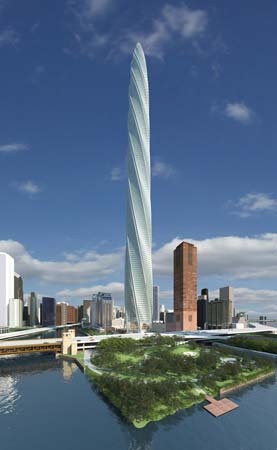Calatrava, Santiago
Spanish architect
in full Santiago Calatrava Valls
born July 28, 1951, Benimamet, near Valencia, Spain
 Spanish architect known for his sculptural bridges and buildings.
Spanish architect known for his sculptural bridges and buildings.Calatrava initiated his architectural studies at the Polytechnic University of Valencia, Spain, graduating in 1974. In 1975 he began a course in structural engineering at the Swiss Federal Institute of Technology (ETH) in Zürich, receiving a Ph.D. in 1979 for a thesis entitled On the Foldability of Frames. In 1981 he established his own architecture and engineering firm in Zürich. (He would later open offices in Paris and Valencia.)
Calatrava gained a reputation for his ability to blend advanced engineering solutions with dramatic visual statements, in both bridges and buildings. When Expo '92 was going to Sevilla, Spain, the city needed to have bridges constructed to allow access to an island that would be used for exhibitions. Calatrava's Alamillo Bridge (1987–92), built for this purpose, instantly received international attention. The dramatic structure's central feature is a 466-foot (142-metre) pylon that inclines asymmetrically away from the river, supporting a span with more than a dozen pairs of cables. The dramatic image, resembling a harp, transformed bridge engineering into a form of sculpture that can invigorate its surrounding landscape. Calatrava's other innovative bridges include the Lusitania Bridge (1988–91) in Mérida, Spain, and the Campo Volantin Footbridge (1990–97) in Bilbao, Spain.
In his architectural commissions, Calatrava used his knowledge of engineering to create innovative, sculptural structures, often in concrete and steel. He stated that nature served as his guide, inspiring him to create buildings that reflected natural shapes and rhythms. He was intensely interested in the architectural use of zoomorphic forms, a passion evident in such buildings as Turning Torso (1999–2005), his unique apartment tower in Malmö, Sweden. Its sculptural shape suggested a twisting spinal column. For the Lyon (France) Airport Railway Station (1989–94), he created a building that resembled a bird with outspread wings; the interior skeletal steel frame reinforced this birdlike effect. The bird allusion had symbolic meaning as well, since the station served as the end point of the route from Lyon to the airport. Calatrava's other memorable buildings include a renovation of the Stadelhofen Railway station (1983–90) in Zürich, the BCE Place Gallery and Heritage Square (1987–92) in Toronto, Tenerife Opera House (1991–2003) in the Canary Islands, and several structures (including an opera house, an arboretum, and a planetarium) for the City of Arts and Sciences (1991–2004) in Valencia.

 In the early 1990s Calatrava begin to add movable aspects to his buildings. In the Kuwait Pavillion for Expo '92 (1991–92), for example, he introduced segmented roof pieces that separate and regroup, creating different shapes and lighting effects. This changeable quality reached new heights in his addition to the Milwaukee (Wisconsin) Museum of Art (1994–2001), for which he created a movable brisé soleil that resembles the wings of a bird as it opens and closes.
In the early 1990s Calatrava begin to add movable aspects to his buildings. In the Kuwait Pavillion for Expo '92 (1991–92), for example, he introduced segmented roof pieces that separate and regroup, creating different shapes and lighting effects. This changeable quality reached new heights in his addition to the Milwaukee (Wisconsin) Museum of Art (1994–2001), for which he created a movable brisé soleil that resembles the wings of a bird as it opens and closes.Calatrava received the contract to design the new rail station on the former site of the World Trade Center in New York City in 2004, and the following year he was awarded the Gold Medal of the American Institute of Architects. In 2007 work began on his design for the world's tallest residential building, the Chicago Spire (2,000 feet 【610 metres】).
Additional Reading
Werner Blaser (ed.), Santiago Calatrava: Ingenieur-Architektur, 2nd rev. and expanded ed. (1991); Dennis Sharp (ed.), Santiago Calatrava, 2nd ed. (1994, reissued 1996); Sergio Polano, Santiago Calatrava: Complete Works (1996); Anthony Tischhauser and Stanislaus von Moos (eds.), Calatrava: Public Buildings (1998); Alexander Tzonis, Santiago Calatrava: The Complete Works (2004); Alexander Tzonis and Rebeca Caso Donadei, Santiago Calatrava: The Bridges (2005).
- pterodactyl
- pteropod
- pteropsid
- Pteroptochidae
- pterosaur
- Pterostyrax
- pterygium
- Ptilodus
- Ptolemaic system
- Ptolemais
- Ptolemy
- Ptolemy Apion
- Ptolemy III Euergetes
- Ptolemy II Philadelphus
- Ptolemy I Soter
- Ptolemy IV Philopator
- Ptolemy IX Soter II
- Ptolemy of Mauretania
- Ptolemy Philadelphus
- Ptolemy V Epiphanes
- Ptolemy VIII Euergetes II
- Ptolemy VII Neos Philopator
- Ptolemy VI Philometor
- Ptolemy X Alexander I
- Ptolemy XI Alexander II